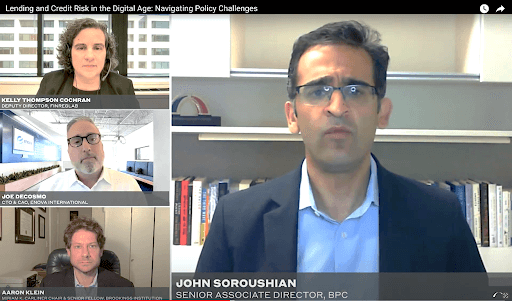Highlights from the Recent Bipartisan Policy Center (BPC) Webinar on the Implications of Lending Digitization

On Thursday, October 19, 2023, the Bipartisan Policy Center (BPC) hosted a live webinar discussion on “Lending and Credit Risk in the Digital Age: Navigating Policy Challenges.” John Soroushian, Senior Associate Director, BPC, moderated the session, which featured several experts, including Enova’s Joe DeCosmo, weighing in on the implications of lending digitization, how it impacts consumers and small businesses, and how policy and regulation should adapt.
Webinar Panel Overview
- Congressman Zach Nunn (R-Iowa)—is a member of both the House Financial Services Committee and the House Agriculture Committee. He also sits on multiple subcommittees focusing on farm commodities, risk management, digital assets, and rural development.
- Overall the congressman shared insights about the challenges Iowa farmers, everyday Americans and major financial institutions face regarding digital assets. Regarding the future of digital assets, he aims to ensure all Americans can safely access leading technology. From his perspective, this includes protecting customers, securing assets and understanding how various digital assets, from cryptocurrencies to advanced tokens, can function optimally.
- Kelly Thompson Cochran, Deputy Director, FinRegLab—spoke about how digitization is reshaping financial services, emphasizing credit underwriting. She noted the research on new data types and machine-learning underwriting techniques aiming to enhance financial access.
- Aaron Klein, Miriam K. Carliner Chair, and senior fellow in Economic Studies at the Brookings Institution—discussed the transformative power of digitization in finance. He underscored its dual nature—while making credit more inclusive, it also risks making offerings too uniform, which may inadvertently exclude certain individuals. He also offered insights into traditional credit decisions, which have predominantly depended on credit scores, explicitly calling out pivotal regulations, such as the Credit Reporting Act and the Equal Credit Opportunity Act, which govern credit reporting and allocation.
- Joe DeCosmo, CTO and Chief Analytics Officer at Enova—elaborated on the need to stay at the forefront of digitization and its innovations. He pointed out the crucial distinction between machine learning (ML) and artificial intelligence (AI), which lies in their ability to learn and make decisions. He further explained how ML and AI are transforming the lending industry by enabling lenders to look beyond just a credit score and identify data patterns that can help them evaluate the borrower’s character and capacity to repay, which are the foundation of lending. Later, Joe explained how Enova’s risk-based pricing strategy gives customers a broader range of terms and options, including for small businesses, based on an evaluation of what they can afford. He reinforced that it is a vital aspect of Enova’s business and something they continuously strive to enhance across all products.
Risk-based Pricing Discussion
- Kelly introduced the topic of risk-based pricing, describing how lenders adjust interest rates according to an applicant’s risk. Joe expanded on this, highlighting Enova’s multifaceted approach beyond the interest rate, considering factors like loan amount and verified income.
- Aaron provided an intriguing perspective on risk-based pricing, touching upon societal considerations. For instance, he highlighted the disparity between financial products and other industries, using the example of risk-based pricing for gender in auto insurance versus its absence in certain credit provisions. He also offered insights into traditional credit decisions, which have predominantly depended on credit scores. He highlighted pivotal regulations, such as the Credit Reporting Act and the Equal Credit Opportunity Act, that govern credit reporting and allocation.
- Joe called out how risk-based pricing is not solely based on the annual percentage rate (APR) or interest rate of the loan, noting it also encompasses the loan amount, repayment term and the ratio of the proposed payment to the customer’s verified income. He emphasized how this comprehensive approach is crucial in shaping Enova’s pricing strategy.
Artificial Intelligence in Financial Lending
- John shifted the discussion to AI—referring to it as a word that constantly reverberates in the financial tech corridors. According to John, the BPC has always been intrigued by AI, especially within the context of the financial sector. Specifically, the application of AI in credit and lending is a topic of keen interest—asking the panelists to address what “We’re using AI” means, especially in the financial sphere.
- Aaron highlighted how the FICO score, widely used in credit assessments, is, in many ways, an AI system. He pointed out how it’s a tool we became accustomed to long before the term “AI” evolved into a mainstream concept. Yet, when explaining how a FICO score is derived or how it might change if, for instance, one applies for a new credit card, the waters become murky. The complexities inherent in this system embody many of the traits we associate with AI today.
- Everyone agreed the need for transparency in AI systems, particularly in credit and lending, cannot be understated. Joe reinforced that customers deserve to know the “why” behind a decision and how the design of AI systems must offer those explanations. Specifically, if a machine can provide a rationale (or multiple rationales) for its decision, it makes the use of AI more acceptable and trustworthy. But there’s a twist: while we hold newer AI systems to rigorous standards of clarity and transparency, older systems like FICO, which have been around long before “AI” became a buzzword, seem to get a pass. They referred to these as “grandfathered,” despite possessing the intricacies and opacities that characterize modern AI systems.
- In the end, the panelists concurred the term “AI” might be ubiquitous, but its meaning can differ substantially depending on the context. Especially in sensitive areas like financial lending, it’s crucial to demystify the term, understand its applications, and ensure that both old and new systems meet the standards of clarity and transparency that customers deserve.